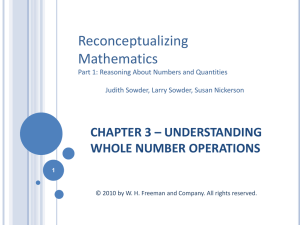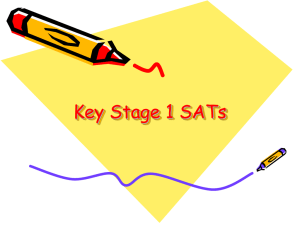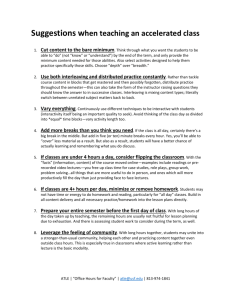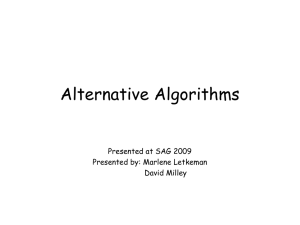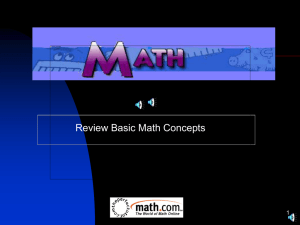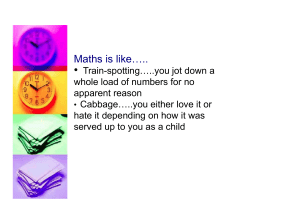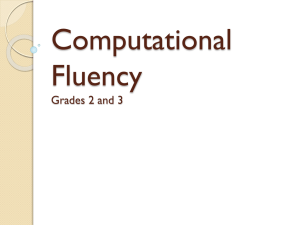Key Stage 1 The Basics
advertisement
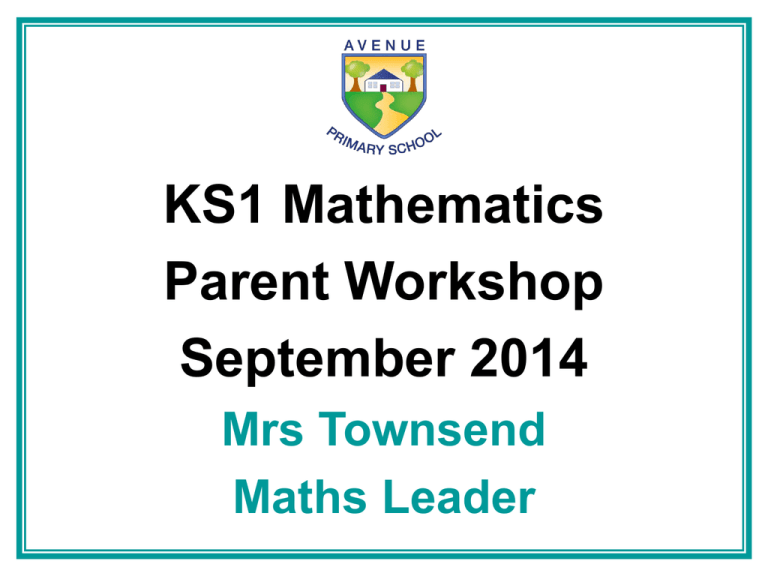
KS1 Mathematics Parent Workshop September 2014 Mrs Townsend Maths Leader Contents - The New Curriculum – what’s new in Key Stage 1 - Key Stage 1 Basics - The 4 operations – including calculation methods used and progression through the key stage - Mental Mathematics: Number bonds, times tables and mental strategies - Problem Solving - Your turn to have a go/Using and Applying - Year 2 SATS & the future of tests - How you can help at home: Online Applications, websites, MyMaths.co.uk Aims - Provide you with a greater understanding of how mathematics is taught in school. - Show you the progression of the 4 operation methods through Key Stage 1. - Enable you to see the types of different questions children are asked in the Year 2 SATs and the new testing procedures. - See the importance of mental mathematics skills and the strategies children are taught. - Help you understand how you can help your child at home. The New Curriculum - More cross curricular - Greater links with Computing - Problem Solving no longer discrete but embedded within each area/domain of mathematics The New Curriculum By the end of Year 2 ALL pupils should know: - Number bonds to 20 - Use and understand place value The New Curriculum How we are implementing the new curriculum Year 1 - Are following the new curriculum - Are being taught the content to enable them to complete the New 2016 Key Stage 1 tests - Are including more work on computers to support and consolidate learning. - Are incorporating more mathematic teaching in topic lessons. The New Curriculum Year 2 (this year) - Are following the objectives from the old curriculum this year. - Are including the extra objectives from the new curriculum into planning. - Are including more work on computers to support and consolidate learning. - Are incorporating more mathematic teaching in topic lessons. Key Stage 1 The Basics •Recognise, read and write numbers: Three 3 Key Stage 1 The Basics •Understand place value: Key Stage 1 The Basics •Put numbers in order: Key Stage 1 The Basics •Count forwards and backwards in same size steps Key Stage 1 The Basics •Partition a number and recombine it Key Stage 1 Number bonds to 10 4 Operations Calculation Methods and Progression The Four Operations Addition and Subtraction Correctly understanding and using the symbols +, - and = Understanding the relationship between adding and subtracting and the importance of order when subtracting and putting the biggest number in their head to count on when adding 9 + 7 = 16 7 + 9 = 16 16 – 7 = 9 16 – 9 = 7 The Four Operations Addition – Practical Resources -Diennes Apparatus -Counters/multi link cubes -Toys -Pebbles 4+3= The Four Operations Addition – Practical Resources -100 square 25 + 9 = The Four Operations Addition - One more - Doubling The Four Operations Addition – Practical Resources -Number Line/Ruler. Starting with single ‘jumps’ and then moving onto jumps of 2, 5, 10 +2 14 +2 16 14 + 6 = 20 +2 18 20 The Four Operations Addition – Partitioning for 2 digit + 2 digit -Number Line/Ruler -2nd digit is partitioned 16 + 12 = 12 is partitioned into T + U 12 = 10 + 2 + 10 16 +1 +1 26 27 28 The Four Operations Addition – Written Method - Bridging through multiples of ten + 30 +4 +4 56 60 56 + 38 = 94 90 94 The Four Operations Addition – Written Methods -Partitioning Partitioning means splitting the number into the tens and units. It is essential that their place value is secure. 56 + 32 = 50 + 30 = 80 (partition tens first) 6+2=8 80 + 8 = 88 (partition units) (add tens and units answer together) The Four Operations Subtraction – Practical Resources -Diennes Apparatus -Counters -Toys -Pebbles 5–2= The Four Operations Subtraction – Practical Resources -Number Line/Ruler 13 – 6 = 1 2 3 4 5 6 7 8 9 10 11 12 13 The Four Operations Subtraction – Practical Resources -100 square 34 – 8 = The Four Operations Subtraction – Finding the difference The Four Operations Subtraction – Counting Backwards -Count back from the largest to the smallest. - 20 -4 -2 48 50 74 – 48 = 20 + 4 + 2 = 26 70 74 The Four Operations Subtraction – Counting On Finding the difference -Count on from the smallest to the largest once again bridging through ten or a multiple of ten. 52 +8 60 74 – 52 = 10 + 8 + 4 = 22 + 10 70 +4 74 The Four Operations Multiplication – Doubling The Four Operations Multiplication – Doubling Moving onto partitioning to double numbers Double 23 = Double 20 + 3 40 + 6 = 46 The Four Operations Multiplication – Practical Resources/Repeated Addition 3 x 5 = (3 groups of 5) = 5 + 5 + 5 = The Four Operations Multiplication – Practical Resources/Repeated Addition 5 x 3 = (5 groups of 3) = 3 + 3 + 3 + 3 + 3 = Children learn that 5 X 3 is the SAME as 3 X 5. This assists with their times tables as well. The Four Operations Multiplication – Number lines/100 square -Children use the number line and the idea of repeated addition to count in groups. 4X3= 3 0 3 3 3 6 3 9 12 The Four Operations Multiplication – Times Tables The Four Operations Multiplication – x 10, 100 - Use of place value chart The Four Operations Multiplication – use of grid method - 2digit x 1digit 13 x 7 = 70 + 21 = 91 The Four Operations Division – Halving The Four Operations Division - Halving Moving onto partitioning to halve numbers Halve 28 = Halve 20 + 8 10 + 4 = 14 The Four Operations Division – Practical Resources – Sharing 15 ÷ 3 = 15 ‘shared between’ 3 = The Four Operations Division – Grouping The number in the group is known but how many groups is unknown. How many 3s in 12? We need to count the number of groups. The Four Operations Division – Corresponding times table facts From here we get the children to use their times tables knowledge to work out the inverse operation 27 ÷ 3 = Children need to use their knowledge of 3 times table to use the corresponding fact 3 x 9 = 27 so 27 ÷3 = 9 The Four Operations Division – Marked number line The Four Operations Division – with remainders Mental Mathematics Mental Maths Strategies: - Use number bonds to 10, 20 and 100 Use doubles and near doubles Counting on and backward in ones, tens Partition into tens and units Put the biggest number first Add 10 then add 1 = adding 11 Add 10 then subtract 1 = adding 9 Subtract 10 then subtract 1 = subtracting 11 Subtract 10 then add 1 = subtracting 9 Your turn Your turn Your turn Your turn Your turn Year 2 SATS -Occur in May. -All children sit the Level 2 paper. -SATs/End of KS1 Result is based on teacher assessment NOT SATS level. -Children will have already attempted past papers so use to the format. -Very relaxed. -Some children will sit the Level 3 paper. Problem Solving Using and applying knowledge and skills Problem Solving - Understanding mathematical vocabulary - Applying strategies taught - Explaining process - Reasoning for why doing that - Justifying answer How you can help at home -Lots of practice – in the car, online games, counting stairs, cars, trees etc -Playing games – cards, snakes and ladders, dominoes -Cooking -Telling the time -MyMaths.co.uk -Online Applications -www.transum.org My Maths Login: Avenue Password: circle Transum.org Online Applications Multi player mental maths game Math Bingo: Four operation bingo Numberjacks: Addition facts up to 10 Four operation practice Squeebles Times Tables 2 Amazing coin: Learn about different British currency Handouts •Presentation •Number formation •How to help your child at home •Mathematics objectives for KS1 Any other questions? Thank you.

